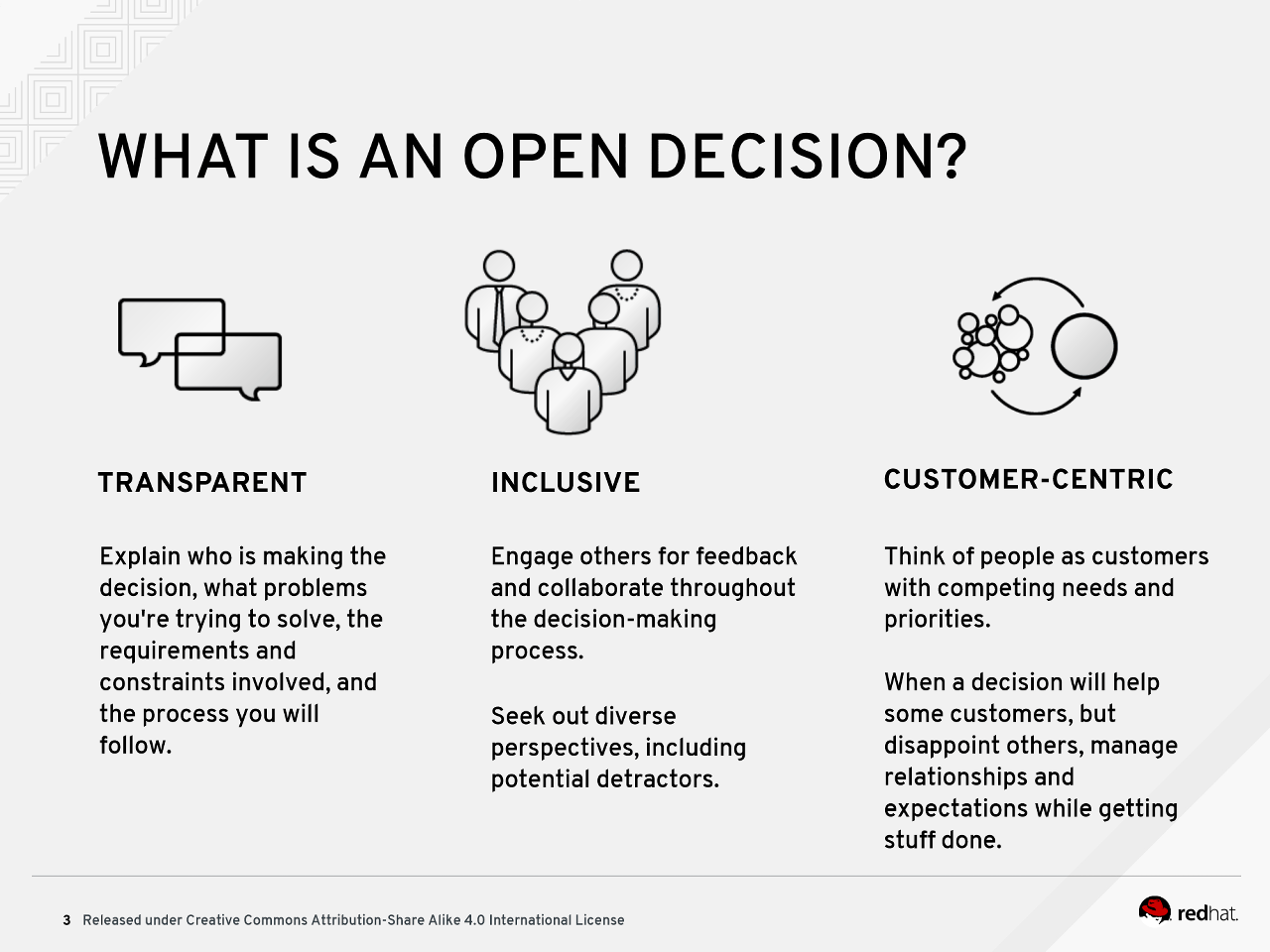Open Decision Framework
How to make transparent, inclusive, and customer-centric decisions
Rebecca Fernandez
Shabnoor Shah
What Is Open Decision Framework?
Open decision making is an approach to arriving at actionable agreements through participatory practices. It is transparent, inclusive, and customer-centric. It involves clearly sharing problems, requirements, and constraints with affected parties; collaborating purposefully with multiple stakeholders to secure diverse opinions and comprehensive feedback; and managing relationships and expectations across competing needs and priorities.
More generally, open decisions facilitate well-functioning meritocracies. For example; Open source communities are meritocratic to the extent that they pragmatically value concrete contributions over formal titles and encourage ideas from all corners of an organization.
The Open Decision Framework illustrates how to take five open source principles--open exchange, participation, meritocracy, community, and “release early, release often”--and put them into practice throughout the process of making a decision or leading a project. The framework is flexible and offers practical steps designed to help teams collaborate with each other, identify and engage stakeholders, manage competing needs and priorities, communicate tradeoffs and business requirements, and make more open decisions.
The Open Decision Framework is available under a Creative Commons CC-BY-SA 4.0 license, and all files are available on GitHub.
Why Do Open Decision Framework?
The framework improves decision-makers ability to communicate transparently, seek out diverse perspectives, collaborate more effectively across distributed teams, and limit unanticipated impacts of business projects and decisions.
Red Hat's open culture – rooted in transparency, collaboration and meritocracy – was highlighted in The Open Organization, by Jim Whitehurst, the company's, then, president and CEO.
As interest in open source – both in technology and as the basis of open management and culture – has taken off, Red Hat created the Open Decision Framework to empower business leaders, decision-makers, and project managers to learn from the experiences of Red Hatters and openly contribute their findings back to the community.
How to do Open Decision Framework?
The Open Decision Framework lists four steps (or "phases") that constitute the open decision-making process:
- Ideation - Lead with transparency for the problem you wish to solve or make a decision on. Openly list possible approaches or constraints on the decision that are immovable.
- Planning and research - Actively engage customers and collaborators. Solicit feedback and set the type of feedback desired. Be open about the timeframe, the scope, the feedback/research done, and how you will respond to negative commentary.
- Design, development, and testing - Investigate the options generated from the feedback, highlight changes done based on the feedback and why other feedback was not feasible or used. Identify and leverage ambassadors to promote the options investigated.
- Launch - Share the steps in making the decision (specifically the incorporation of the feedback). Acknowledge and be prepared to make the decision one that is continuously updated based on feedback.
You can use the Open Decision Framework with your teams today! download copies available online. You can read the plain text version and even download presentation slides that explains the framework.
You might also consider sharing the framework with your team's or organization's leadership. Track your team's progress using the Open Decision Framework Maturity Model
The framework is powered by open source principles:
Open exchange
Whether you're developing software or trying to solve a business problem, open exchange begins when you share your "source code" with others. A free exchange of ideas is critical to creating an environment where people can learn and use existing information to develop new ideas.
Participation
When we are free to collaborate, we create. We can solve problems that no one person may be able to solve on their own. And when we can implement open standards, we enable others to participate in the future.
Release early + often
Rapid prototypes can lead to rapid failures, and that leads to better solutions faster. When you're free to experiment, you can look at problems in new ways and look for answers in new places. You can learn by doing.
Meritocracy
In a meritocracy, good ideas can come from anywhere, and the best ideas win. Everyone has access to the same information. Successful work determines which projects rise and gather support and effort from the community.
Community
Communities form around a common purpose. They bring together diverse ideas and share work. Together, a global community can create beyond the capabilities of any one individual. It multiplies effort and shares the work. Together, we can do more.
Look at Open Decision Framework
Links we love
Check out these great links which can help you dive a little deeper into running the Open Decision Framework practice with your team, customers or stakeholders.


